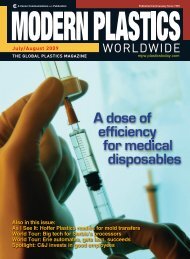Modern Plastics Worldwide - March 2010 - dae uptlax
Modern Plastics Worldwide - March 2010 - dae uptlax
Modern Plastics Worldwide - March 2010 - dae uptlax
Create successful ePaper yourself
Turn your PDF publications into a flip-book with our unique Google optimized e-Paper software.
MODERN EXECUTIVE<br />
O fficials<br />
An “Xten-sive” look at life as an<br />
American molder: Chapter 1<br />
By Clare Goldsberry Did the recession slow the pace of progress at your company? Likely it did,<br />
at Xten Industries, a custom<br />
injection molder and contract<br />
manufacturer in Kenosha, WI, believe<br />
that sustainability and profitability are<br />
not competing goals. They also are out<br />
to prove that profitable manufacturing<br />
and “Made in the U.S.A.” are not mutually<br />
exclusive terms.<br />
“Sustainability is about making<br />
responsible choices that help the environment<br />
and ensure that your company will<br />
survive the business pressures it faces,”<br />
says Mark Dirr, Xten’s director of engineering.<br />
“Ultimately, this is how you<br />
must approach your efforts to be a more<br />
sustainable operation—the two go hand<br />
in hand. When you find ways to responsibly<br />
use less of anything, you reduce<br />
your expenses, and that goes directly to<br />
your bottom line.”<br />
Xten Industries, formerly Hauser<br />
PlasTech, experienced strong growth<br />
over the past few years. During this<br />
recession the company saw some drop<br />
in business early on, but by September<br />
2009 things had picked up substantially.<br />
Because of this growth, explains Xten’s<br />
president Matthew Davidson, the company<br />
was reaching the limits of its elec-<br />
Quick facts:<br />
Xten Industries<br />
Where? Kenosha, WI<br />
How big? 78,000 ft 2 of manufacturing,<br />
office, and warehouse space<br />
Who’s there? 80 employees; Matthew<br />
Davidson, president<br />
What machines? 30 injection molding<br />
presses, 85-880 tons; all hydraulic<br />
except for a 400-ton electric<br />
but that does not mean you still aren’t striving to improve. In this, fi rst in a<br />
four-part series, MPW will be tracking one company’s efforts to be sustainable<br />
and profi table.<br />
Xten’s director of engineering, Mark Dirr, is helping the company pursue a number of<br />
different approaches to more sustainable, and more profitable, plastics processing.<br />
trical capacity. It was time to think about<br />
energy use and ways the company might<br />
save on electrical costs.<br />
Xten’s local utility, Wisconsin Energy<br />
(WE), offers a program in which it<br />
will evaluate a company’s current energy<br />
usage and estimated future needs.<br />
“Beyond saving money, we had the incentive<br />
of finding a solution to our upcoming<br />
capacity limits,” says Davidson. “Unless<br />
we became more efficient with the equipment<br />
we had, we’d have to invest heavily<br />
to expand our electrical capacity, which<br />
would cost us over $100,000. Our goal<br />
became cost avoidance and learning to<br />
live within our kilowatt means. The fact<br />
that we were helping to cut overall electrical<br />
consumption was an added benefit.”<br />
Xten began its sustainability effort<br />
with small steps—from the installation<br />
of energy-efficient lighting and motion<br />
sensors for turning lights on and off<br />
in offices or infrequently used warehouse<br />
bays, to employee training and<br />
working with the community. The com-<br />
pany also purchased an Ingersoll Rand<br />
Nirvana VSD rotary-screw air compressor<br />
and installed a variable-frequency<br />
drive (VFD) on its cooling tower system’s<br />
pump. These steps coincided with<br />
research on possible future projects such<br />
as reducing inline air pressure settings,<br />
heater bands, and potentially the purchase<br />
of an electric press.<br />
If at fi rst you don’t succeed . . .<br />
Not everything Xten tried worked out<br />
well. One of those missteps was the<br />
Power Factor Correction. The company<br />
installed a capacitor bank to reduce its<br />
peak power demand and improve its<br />
power factor, which is an evaluation of<br />
the unused power being returned to the<br />
electrical provider, measuring the number<br />
of degrees the current and voltage are<br />
out of phase with the power company.<br />
The better the alignment between these<br />
curves, the more efficiently the power<br />
plant can operate, explains Dirr.<br />
Sounds good, but the process failed<br />
8 MARCH <strong>2010</strong> • MODERN PLASTICS WORLDWIDE plasticstoday.com/mpw









